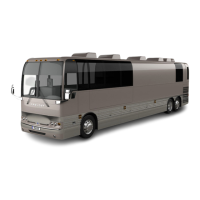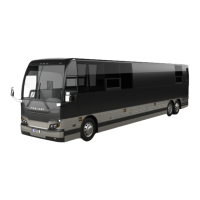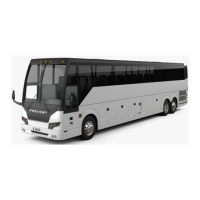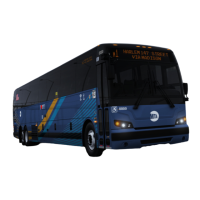Do you have a question about the PREVOST H3-45 2023 and is the answer not in the manual?
This manual acquaints the driver and technicians with vehicle equipment and features for safe operation.
Information regarding California Proposition 65 warnings about diesel engine exhaust.
Guidelines for maintaining and replacing emission control devices and systems.
Details about Event Data Recorders (EDR) that record vehicle data before and after an event.
Information on the vehicle's ELD interface connector and warnings about OBD port usage.
Information on Prevost's Connected Vehicle Services (Telematics) and data collection.
Instructions for updating owner records with Prevost Warranty Support.
Procedure for addressing questions or complaints with Prevost service personnel.
Guidance on reporting safety defects to NHTSA (US) and Transport Canada (Canada).
Essential safety precautions for ensuring safe and reliable vehicle operation.
Tips for maintaining safe following distances and situational awareness while driving.
Additional safety warnings, including vehicle design limitations and electrical system precautions.
Diagrams illustrating the exterior components and their locations on the H3-45 coach.
Identification of key components within the engine compartment.
Procedure for opening the engine compartment door and its safety catch.
Instructions for accessing the DPF system hatch.
Description of the optional back-up camera system for visual assistance.
Procedure for opening the curbside engine compartment door.
Details on the 120-volt connectors for accessories like the engine block heater.
Information on the optional engine block heater and its connection.
Information on connecting the battery charger to a 120 VAC power source.
Description of the main power compartment and its housed electrical components.
Instructions for opening the optional wheelchair lift access doors.
Procedure for accessing the fuel and DEF filler necks.
Procedure for opening the HVAC condenser compartment door.
Information on operating and securing baggage compartment doors.
Details on the operation and locking mechanisms of the coach's entrance door.
Instructions for locking and unlocking the entrance door from the outside.
Procedure for pneumatically controlling the entrance door from outside.
Explanation of how the entrance door mechanism holds pressure and operates.
Reference to emergency opening procedures for the entrance door.
Instructions for tilting the front bumper to access the compartment.
Procedure for opening the wiper mechanism access hatch.
Description and operation of the coach's headlights and lighting functions.
Access and contents of the front electrical and service compartment.
Information on the types of rear-view mirrors and their adjustment.
Details on the optional side camera system for improved visibility.
Procedure to access the evaporator compartment.
Instructions for opening the street side fuel filler neck access hatch.
Procedure for opening the radiator door to access the release handle.
Location and access to the SCR converter.
Information on the factory-installed trailer hitch and its rating.
Requirements and limitations for using the trailer hitch safely.
Location and description of utility compartments on the dashboard.
Description of the lockable compartment for the driver near the entrance stepwell.
Locations of microphone jacks for the PA system.
Information on the ISRI driver's seats, including mechanical and pneumatic models.
Adjustment instructions for the mechanical ISRI driver's seat.
Details and adjustments for the pneumatic ISRI driver's seat.
Features of the USSC 9100ALX air suspension seat.
Instructions and safety guidelines for using the driver's seat belt.
Description of passenger seats, including track mounting and tilt adjustments.
Procedure for rotating swivel seats for privacy or card table setup.
Advice for passengers on wearing seat belts, including child restraint use.
Guidelines for using child seats and booster seats with the vehicle's seat belts.
Information on optional folding tray models for passenger use.
Instructions for installing removable tables provided for passenger seating.
Description of amenities in the overhead console, including lights and air registers.
How to adjust air registers for passenger comfort.
Operation of the service chime system for passenger requests.
Location and operation of reading lights under overhead compartments.
Information on the vehicle's windows, including panoramic and fixed types.
Details on panoramic side windows, including single pane and double pane options.
Operation of the driver's power window controlled by a dashboard switch.
Operation of the driver's side window sunshade.
Operation and safety considerations for ventilation and emergency egress hatches.
Storage of passenger carry-on baggage in overhead compartments.
Location and accessibility of the waste container in the lavatory.
Features and operation of the optional galley, including microwave and refrigerator.
Description of the lavatory's features and ventilation system.
Information on the different types of keys provided with the coach.
Usage of the entrance door key for exterior locking/unlocking.
Usage of the exterior compartment key for various compartment doors.
Usage of the key for the paper towel dispenser in the lavatory.
Illustration and overview of the driver's area layout and controls.
Identification and function of controls on the lateral control panel.
Procedure for starting the engine using the engine start button.
Location and power capacity of the 12-volt DC power outlet.
Location and reference to Allison Transmission operating instructions.
Instructions for adjusting and operating the vehicle's mirrors.
Contents of the lateral utility compartment, including USB chargers.
Description of the AFSS system and its protection panel.
Explanation of the AFSS protection panel indicators and switches.
Overview of the dashboard layout and controls.
Description and function of various control switches, including indicator LEDs.
Procedure for applying and releasing the parking brake.
Operation of the VSS-06 selector for audio and video sources.
Connecting and displaying content from external devices on the modesty panel.
Overview of the DEA600 radio and infotainment display system.
Operation of the central HVAC system for driver and passenger comfort.
Identification of gauges and indicators on the instrument panel.
Explanation of information levels presented on the instrument panel.
Description of analog gauges like tachometer, speedometer, and pressure indicators.
Explanation of telltale lights and their function during vehicle operation.
Meaning and required action for STOP and CHECK telltale lights.
Functionality and display elements of the Driver Information Display (DID).
Conveniently placed controls on the steering column and wheel for driver operation.
Operation of the directional indicator and high beam control stalk.
Instructions for operating the windshield wipers and their speeds.
Explanation of the auxiliary brake function and its control stalk.
Controls on the steering wheel for horn, lighting, cruise control, and infotainment.
Description of foot pedals for steering wheel adjustment, brake, and accelerator.
Details on the dual braking system and safe braking practices.
Function of the accelerator pedal in controlling engine RPM.
Location of the OBD receptacle for accessing diagnostic data.
Description of the TPMS system and its warnings.
Operation and features of the vehicle's cruise control system.
Overview of Prevost Driver Assist systems (ADAS) and associated hardware.
Functionality of Adaptive Cruise with Braking (ACB) for maintaining speed and distance.
General information and operation of the Allison automatic transmission.
Safety precautions and procedures for towing the vehicle.
Components and function of the exhaust aftertreatment system.
Procedure for initiating and managing stationary DPF regeneration.
Driver warnings and system responses for various emission control conditions.
Description of the battery-saving ISM mode and its activation conditions.
Benefits and operation of the transmission retarder for speed control.
Function and operation of the engine brake system for speed reduction.
Operation of the kneeling system to lower the front end for passenger access.
Operation of the low-buoy system to lower the coach for overhead clearance.
Functionality of the automatic tag axle unload system.
Operation and maintenance of the optional auxiliary heating system.
Introduction to the Ricon wheelchair lift system and its major components.
Safety preparations and procedures for manual operation of the wheelchair lift.
Instructions for folding and sliding seats to accommodate wheelchairs.
Description of 4-point wheelchair and occupant securement systems.
General procedures for starting the engine from the driver's seat.
Step-by-step instructions for starting the engine from the driver's seat.
Procedure for starting the engine using the rear start panel.
Precautions and procedures for starting the engine in cold weather.
Instructions and safety warnings for jump starting the vehicle's battery.
How the engine protection system derates or stops the engine under critical conditions.
Process of automatic engine derate, idle, and shutdown due to critical conditions.
Information on the optional idle shutdown timer that automatically stops the engine.
Usage and connection of the optional engine block heater for cold weather starting.
Procedure for warming up the engine after starting, including idle times.
Warm-up procedures for the Allison transmission in cold temperatures.
Instructions on locating and using all possible emergency exits.
How to open side windows from the inside as emergency exits.
Operation of roof hatches as emergency exits.
Procedures for emergency opening of the entrance door.
Overview of safety features and equipment found on board.
Locations and instructions for using fire extinguishers.
Location of the optional first-aid kit.
Location of the optional fire hatchet.
Use of triangular reflectors for roadside warnings.
Contents of the kit for jacking up the vehicle and changing wheels.
Contents of the optional spare parts kit.
System operation for fire detection and suppression in the engine compartment.
Instructions for installing the limp-home belt in case of lower alternator failure.
Procedure for installing the limp-home belt on the upper alternator.
Location of the spare wheel and tire and steps for changing a wheel.
Detailed steps for accessing and changing a wheel.
Information and precautions for replacing a super single tire.
Location and usage of emergency air-fill valves for the air system.
Operation of emergency and parking brakes, including air pressure warnings.
Reference to maintenance information for vehicle jacking points.
Instructions for operating the hydraulic jack for raising and lowering.
Reference to maintenance information for towing the vehicle.
Operation and usage of the daytime running lights system.
Information on optional fog lights for improved visibility.
Automatic operation of compartment lights when doors are opened.
Function of mud flaps and splash guards to protect vehicle surfaces.
Description of the optional back-up camera for driver assistance.
Function of the back-up alarm to alert pedestrians and drivers.
Maintained essential functions for driving in case of system failures.
List of basic functions available in limp-home mode.
Recommended cleaning practices for various interior and exterior surfaces.
Methods for cleaning seat upholstery to remove dust and dirt.
Cleaning procedures for plastic and vinyl trim surfaces.
Instructions for cleaning the inside of windows with a vinegar solution.
Guidelines for cleaning stainless steel surfaces.
Methods for removing stains from laminated surfaces.
Recommendations for vacuuming carpets to prolong their life.
Cleaning recommendations for rubber components.
Procedures for cleaning and polishing floors to maintain appearance.
Washing and waxing the vehicle exterior to protect the finish.
Tips to prevent windshield wiper streaking and clean windows.
Maintenance procedures for the lavatory's waste and fresh water tanks.
Instructions for filling and draining lavatory waste water tanks.
Procedures for filling and draining the fresh water reservoir.
Importance of periodic inspection of oil and fluid levels for vehicle performance.
Procedure for checking and maintaining the engine oil level.
Procedure for checking the Allison transmission fluid level.
Location and method for checking the power steering fluid level.
Lubrication of drive axle wheel bearings by differential oil.
Information on unitized hub bearings for front and tag axles.
Checking the coolant level in the surge and recovery tanks.
Location and checking of windshield and headlight washer fluid levels.
Regular inspection of vehicle components for wear and safety routines.
Inspection and cleaning procedures for electric cooling fan blades.
Monthly inspection of fire extinguishers to ensure operation.
Function and maintenance of the primary fuel filter.
Information on the V-belts driving the air conditioning compressor.
Details on automatic belt tensioners for alternator drive belts.
Cleaning and maintenance of the optional back-up camera.
Function and replacement of the engine air filter restriction indicator.
Inspection and cleaning of air filters for HVAC system efficiency.
Regular inspection of hoses for leaks and chafing to ensure safety.
Greasing lubrication points during scheduled maintenance.
Checking wheels, nuts, and tire inflation pressure for safety.
Checking wheel bearings for overheating after brake usage.
Procedure for testing service brake pressure build-up and loss.
Procedure for testing the parking brake system and air pressure.
Using test mode to quickly verify vehicle exterior lights.
Detailed dimensions and weight specifications for the H3-45 coach.
Fluid capacities for engine, fuel, cooling, and other vehicle systems.
Theoretical turning radius values for normal driving and low-speed maneuvering.
Required fuel type (ULSD) and warnings about using alternative fuels like biodiesel.
Specifications for wheels and tire dimensions, including recommended inflation pressure.
Diagrams illustrating the routing of engine belts.
Technical specifications for the Volvo D13 engine.
Specifications for the Allison B500 automatic transmission.
Gear ratios for the Allison transmission.
Details on the Dana Spicer propeller shafts.
Features of the air-operated disc brake system.
Information on the compressed air system components.
Function and components of the ABS system.
Details on ATC and ESC systems for improved traction and stability.
Specifications for the ZF integral hydraulic assisted steering gear.
Specifications for the vehicle's electrical system, including batteries and alternators.
Details on front, drive, and tag axles, including suspension and bearings.
Information on Goodyear rolling lobe air springs used in the suspension.
Static wheel alignment specifications for various axles.
Specifications for the cooling system, including radiator, fans, and coolant.
Details on the polyethylene fuel tank and its components.
Description of the stainless steel exhaust and aftertreatment system.
Overview of the central HVAC system and its controls.
Information on locating engine, transmission, and axle serial numbers for parts ordering.
Conformity of vehicle components to ASTM, SAE, and FMVSS standards.
Information contained on the DOT certification plate regarding vehicle specifications.
Emissions certification label confirming engine compliance with regulations.
Location and importance of the VIN for ordering parts and registration.
Explanation of the structure and meaning of each character in the VIN.
Record of vehicle assembly data to be retained for reference.
Procedure for checking transmission fluid level using the OLS and shift selector.
Monitoring transmission operating parameters like oil and filter life.
Prognostic feature determining clutch life status and maintenance needs.
Overview of Diagnostic Trouble Codes (DTCs) used to identify transmission malfunctions.
Methods for reading and clearing diagnostic trouble codes using the shift selector.
List of DTCs, their descriptions, check lights, and inhibited operations.
This manual acquaints the driver and technicians with vehicle equipment and features for safe operation.
Information regarding California Proposition 65 warnings about diesel engine exhaust.
Guidelines for maintaining and replacing emission control devices and systems.
Details about Event Data Recorders (EDR) that record vehicle data before and after an event.
Information on the vehicle's ELD interface connector and warnings about OBD port usage.
Information on Prevost's Connected Vehicle Services (Telematics) and data collection.
Instructions for updating owner records with Prevost Warranty Support.
Procedure for addressing questions or complaints with Prevost service personnel.
Guidance on reporting safety defects to NHTSA (US) and Transport Canada (Canada).
Essential safety precautions for ensuring safe and reliable vehicle operation.
Tips for maintaining safe following distances and situational awareness while driving.
Additional safety warnings, including vehicle design limitations and electrical system precautions.
Diagrams illustrating the exterior components and their locations on the H3-45 coach.
Identification of key components within the engine compartment.
Procedure for opening the engine compartment door and its safety catch.
Instructions for accessing the DPF system hatch.
Description of the optional back-up camera system for visual assistance.
Procedure for opening the curbside engine compartment door.
Details on the 120-volt connectors for accessories like the engine block heater.
Information on the optional engine block heater and its connection.
Information on connecting the battery charger to a 120 VAC power source.
Description of the main power compartment and its housed electrical components.
Instructions for opening the optional wheelchair lift access doors.
Procedure for accessing the fuel and DEF filler necks.
Procedure for opening the HVAC condenser compartment door.
Information on operating and securing baggage compartment doors.
Details on the operation and locking mechanisms of the coach's entrance door.
Instructions for locking and unlocking the entrance door from the outside.
Procedure for pneumatically controlling the entrance door from outside.
Explanation of how the entrance door mechanism holds pressure and operates.
Reference to emergency opening procedures for the entrance door.
Instructions for tilting the front bumper to access the compartment.
Procedure for opening the wiper mechanism access hatch.
Description and operation of the coach's headlights and lighting functions.
Access and contents of the front electrical and service compartment.
Information on the types of rear-view mirrors and their adjustment.
Details on the optional side camera system for improved visibility.
Procedure to access the evaporator compartment.
Instructions for opening the street side fuel filler neck access hatch.
Procedure for opening the radiator door to access the release handle.
Location and access to the SCR converter.
Information on the factory-installed trailer hitch and its rating.
Requirements and limitations for using the trailer hitch safely.
Location and description of utility compartments on the dashboard.
Description of the lockable compartment for the driver near the entrance stepwell.
Locations of microphone jacks for the PA system.
Information on the ISRI driver's seats, including mechanical and pneumatic models.
Adjustment instructions for the mechanical ISRI driver's seat.
Details and adjustments for the pneumatic ISRI driver's seat.
Features of the USSC 9100ALX air suspension seat.
Instructions and safety guidelines for using the driver's seat belt.
Description of passenger seats, including track mounting and tilt adjustments.
Procedure for rotating swivel seats for privacy or card table setup.
Advice for passengers on wearing seat belts, including child restraint use.
Guidelines for using child seats and booster seats with the vehicle's seat belts.
Information on optional folding tray models for passenger use.
Instructions for installing removable tables provided for passenger seating.
Description of amenities in the overhead console, including lights and air registers.
How to adjust air registers for passenger comfort.
Operation of the service chime system for passenger requests.
Location and operation of reading lights under overhead compartments.
Information on the vehicle's windows, including panoramic and fixed types.
Details on panoramic side windows, including single pane and double pane options.
Operation of the driver's power window controlled by a dashboard switch.
Operation of the driver's side window sunshade.
Operation and safety considerations for ventilation and emergency egress hatches.
Storage of passenger carry-on baggage in overhead compartments.
Location and accessibility of the waste container in the lavatory.
Features and operation of the optional galley, including microwave and refrigerator.
Description of the lavatory's features and ventilation system.
Information on the different types of keys provided with the coach.
Usage of the entrance door key for exterior locking/unlocking.
Usage of the exterior compartment key for various compartment doors.
Usage of the key for the paper towel dispenser in the lavatory.
Illustration and overview of the driver's area layout and controls.
Identification and function of controls on the lateral control panel.
Procedure for starting the engine using the engine start button.
Location and power capacity of the 12-volt DC power outlet.
Location and reference to Allison Transmission operating instructions.
Instructions for adjusting and operating the vehicle's mirrors.
Contents of the lateral utility compartment, including USB chargers.
Description of the AFSS system and its protection panel.
Explanation of the AFSS protection panel indicators and switches.
Overview of the dashboard layout and controls.
Description and function of various control switches, including indicator LEDs.
Procedure for applying and releasing the parking brake.
Operation of the VSS-06 selector for audio and video sources.
Connecting and displaying content from external devices on the modesty panel.
Overview of the DEA600 radio and infotainment display system.
Operation of the central HVAC system for driver and passenger comfort.
Identification of gauges and indicators on the instrument panel.
Explanation of information levels presented on the instrument panel.
Description of analog gauges like tachometer, speedometer, and pressure indicators.
Explanation of telltale lights and their function during vehicle operation.
Meaning and required action for STOP and CHECK telltale lights.
Functionality and display elements of the Driver Information Display (DID).
Conveniently placed controls on the steering column and wheel for driver operation.
Operation of the directional indicator and high beam control stalk.
Instructions for operating the windshield wipers and their speeds.
Explanation of the auxiliary brake function and its control stalk.
Controls on the steering wheel for horn, lighting, cruise control, and infotainment.
Description of foot pedals for steering wheel adjustment, brake, and accelerator.
Details on the dual braking system and safe braking practices.
Function of the accelerator pedal in controlling engine RPM.
Location of the OBD receptacle for accessing diagnostic data.
Description of the TPMS system and its warnings.
Operation and features of the vehicle's cruise control system.
Overview of Prevost Driver Assist systems (ADAS) and associated hardware.
Functionality of Adaptive Cruise with Braking (ACB) for maintaining speed and distance.
General information and operation of the Allison automatic transmission.
Safety precautions and procedures for towing the vehicle.
Components and function of the exhaust aftertreatment system.
Procedure for initiating and managing stationary DPF regeneration.
Driver warnings and system responses for various emission control conditions.
Description of the battery-saving ISM mode and its activation conditions.
Benefits and operation of the transmission retarder for speed control.
Function and operation of the engine brake system for speed reduction.
Operation of the kneeling system to lower the front end for passenger access.
Operation of the low-buoy system to lower the coach for overhead clearance.
Functionality of the automatic tag axle unload system.
Operation and maintenance of the optional auxiliary heating system.
Introduction to the Ricon wheelchair lift system and its major components.
Safety preparations and procedures for manual operation of the wheelchair lift.
Instructions for folding and sliding seats to accommodate wheelchairs.
Description of 4-point wheelchair and occupant securement systems.
General procedures for starting the engine from the driver's seat.
Step-by-step instructions for starting the engine from the driver's seat.
Procedure for starting the engine using the rear start panel.
Precautions and procedures for starting the engine in cold weather.
Instructions and safety warnings for jump starting the vehicle's battery.
How the engine protection system derates or stops the engine under critical conditions.
Process of automatic engine derate, idle, and shutdown due to critical conditions.
Information on the optional idle shutdown timer that automatically stops the engine.
Usage and connection of the optional engine block heater for cold weather starting.
Procedure for warming up the engine after starting, including idle times.
Warm-up procedures for the Allison transmission in cold temperatures.
Instructions on locating and using all possible emergency exits.
How to open side windows from the inside as emergency exits.
Operation of roof hatches as emergency exits.
Procedures for emergency opening of the entrance door.
Overview of safety features and equipment found on board.
Locations and instructions for using fire extinguishers.
Location of the optional first-aid kit.
Location of the optional fire hatchet.
Use of triangular reflectors for roadside warnings.
Contents of the kit for jacking up the vehicle and changing wheels.
Contents of the optional spare parts kit.
System operation for fire detection and suppression in the engine compartment.
Instructions for installing the limp-home belt in case of lower alternator failure.
Procedure for installing the limp-home belt on the upper alternator.
Location of the spare wheel and tire and steps for changing a wheel.
Detailed steps for accessing and changing a wheel.
Information and precautions for replacing a super single tire.
Location and usage of emergency air-fill valves for the air system.
Operation of emergency and parking brakes, including air pressure warnings.
Reference to maintenance information for vehicle jacking points.
Instructions for operating the hydraulic jack for raising and lowering.
Reference to maintenance information for towing the vehicle.
Operation and usage of the daytime running lights system.
Information on optional fog lights for improved visibility.
Automatic operation of compartment lights when doors are opened.
Function of mud flaps and splash guards to protect vehicle surfaces.
Description of the optional back-up camera for driver assistance.
Function of the back-up alarm to alert pedestrians and drivers.
Maintained essential functions for driving in case of system failures.
List of basic functions available in limp-home mode.
Recommended cleaning practices for various interior and exterior surfaces.
Methods for cleaning seat upholstery to remove dust and dirt.
Cleaning procedures for plastic and vinyl trim surfaces.
Instructions for cleaning the inside of windows with a vinegar solution.
Guidelines for cleaning stainless steel surfaces.
Methods for removing stains from laminated surfaces.
Recommendations for vacuuming carpets to prolong their life.
Cleaning recommendations for rubber components.
Procedures for cleaning and polishing floors to maintain appearance.
Washing and waxing the vehicle exterior to protect the finish.
Tips to prevent windshield wiper streaking and clean windows.
Maintenance procedures for the lavatory's waste and fresh water tanks.
Instructions for filling and draining lavatory waste water tanks.
Procedures for filling and draining the fresh water reservoir.
Importance of periodic inspection of oil and fluid levels for vehicle performance.
Procedure for checking and maintaining the engine oil level.
Procedure for checking the Allison transmission fluid level.
Location and method for checking the power steering fluid level.
Lubrication of drive axle wheel bearings by differential oil.
Information on unitized hub bearings for front and tag axles.
Checking the coolant level in the surge and recovery tanks.
Location and checking of windshield and headlight washer fluid levels.
Regular inspection of vehicle components for wear and safety routines.
Inspection and cleaning procedures for electric cooling fan blades.
Monthly inspection of fire extinguishers to ensure operation.
Function and maintenance of the primary fuel filter.
Information on the V-belts driving the air conditioning compressor.
Details on automatic belt tensioners for alternator drive belts.
Cleaning and maintenance of the optional back-up camera.
Function and replacement of the engine air filter restriction indicator.
Inspection and cleaning of air filters for HVAC system efficiency.
Regular inspection of hoses for leaks and chafing to ensure safety.
Greasing lubrication points during scheduled maintenance.
Checking wheels, nuts, and tire inflation pressure for safety.
Checking wheel bearings for overheating after brake usage.
Procedure for testing service brake pressure build-up and loss.
Procedure for testing the parking brake system and air pressure.
Using test mode to quickly verify vehicle exterior lights.
Detailed dimensions and weight specifications for the H3-45 coach.
Fluid capacities for engine, fuel, cooling, and other vehicle systems.
Theoretical turning radius values for normal driving and low-speed maneuvering.
Required fuel type (ULSD) and warnings about using alternative fuels like biodiesel.
Specifications for wheels and tire dimensions, including recommended inflation pressure.
Diagrams illustrating the routing of engine belts.
Technical specifications for the Volvo D13 engine.
Specifications for the Allison B500 automatic transmission.
Gear ratios for the Allison transmission.
Details on the Dana Spicer propeller shafts.
Features of the air-operated disc brake system.
Information on the compressed air system components.
Function and components of the ABS system.
Details on ATC and ESC systems for improved traction and stability.
Specifications for the ZF integral hydraulic assisted steering gear.
Specifications for the vehicle's electrical system, including batteries and alternators.
Details on front, drive, and tag axles, including suspension and bearings.
Information on Goodyear rolling lobe air springs used in the suspension.
Static wheel alignment specifications for various axles.
Specifications for the cooling system, including radiator, fans, and coolant.
Details on the polyethylene fuel tank and its components.
Description of the stainless steel exhaust and aftertreatment system.
Overview of the central HVAC system and its controls.
Information on locating engine, transmission, and axle serial numbers for parts ordering.
Conformity of vehicle components to ASTM, SAE, and FMVSS standards.
Information contained on the DOT certification plate regarding vehicle specifications.
Emissions certification label confirming engine compliance with regulations.
Location and importance of the VIN for ordering parts and registration.
Explanation of the structure and meaning of each character in the VIN.
Record of vehicle assembly data to be retained for reference.
Procedure for checking transmission fluid level using the OLS and shift selector.
Monitoring transmission operating parameters like oil and filter life.
Prognostic feature determining clutch life status and maintenance needs.
Overview of Diagnostic Trouble Codes (DTCs) used to identify transmission malfunctions.
Methods for reading and clearing diagnostic trouble codes using the shift selector.
List of DTCs, their descriptions, check lights, and inhibited operations.
| Manufacturer | Prevost |
|---|---|
| Model | H3-45 |
| Year | 2023 |
| Category | Buses |
| Engine | Volvo D13 |
| Horsepower | 500 hp |
| Length | 45 ft |
| Width | 102 in |
| Seating Capacity | 56 passengers |
| Air Conditioning | Yes |
| GVWR | 54, 000 lbs |
| Entertainment System | Available |











